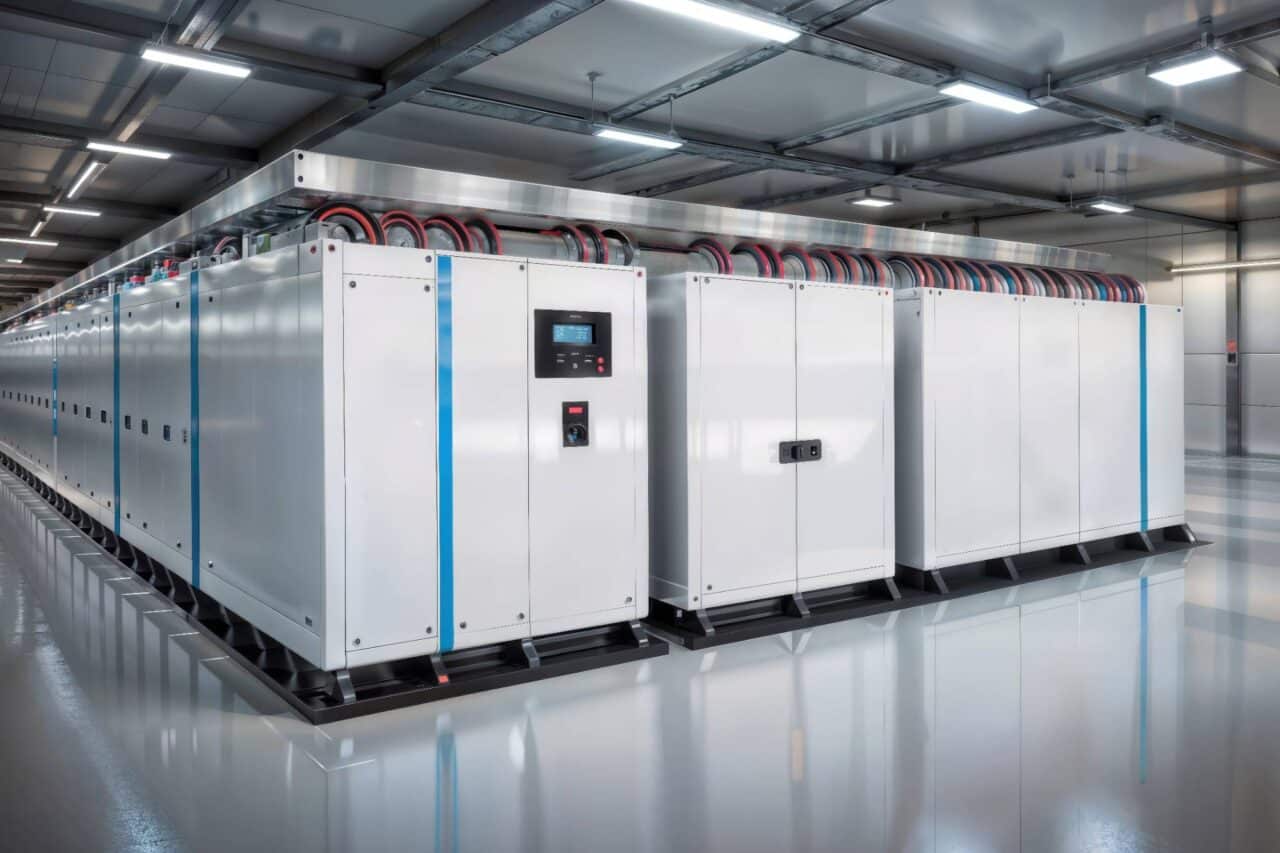What happens when the power cuts out, and your servers, emergency lighting, or security systems are left hanging? It’s not just downtime but missed revenue, compromised safety, and a potential compliance nightmare.
An Uninterruptible Power Supply (UPS) gives you precious minutes — or hours — to respond before systems go dark. But UPS battery life isn’t one-size-fits-all, and overestimating it can lead to costly surprises when the lights go out.
With eight decades of experience installing and maintaining commercial UPS systems, our FM2 team helps businesses across the Southeast stay protected. Here’s how long a UPS can realistically support your systems and how to get more out of every battery cycle.
Typical UPS Battery Runtime
How long will your UPS actually hold the line when the power goes out? It depends on:
- The type of unit you’re using.
- What you’ve plugged into it.
Whether you’re protecting a single network closet or keeping a hospital’s life safety systems online, understanding UPS battery runtime is critical for proper planning. Below is a tiered breakdown of what you can realistically expect based on how your facility operates.
Entry-Level/Consumer UPS
These are the small, tower-style units you’ll find under desks or in breakroom IT closets. They’re designed to give a few minutes of backup to devices like point-of-sale terminals, basic desktops, or wall-mounted Wi-Fi routers.
- Runtime: 5–20 minutes
For example, a 600VA UPS running a desktop and monitor might give you 8–12 minutes of backup time. Just enough to prevent file loss but not to ride out an extended outage.
Mid-Range/Home Office UPS
These units are standard in smaller commercial setups like dental offices, distribution center control rooms, or retail back offices. They often support a handful of devices: routers, switches, a NAS, maybe a single rack-mounted server.
- Runtime: 20–45 minutes
A 1500VA UPS connected to a router, switch, and a compact server might offer around 30 minutes of power during a blackout. This is long enough to keep operations online while staff switch over to a backup generator or cloud solution.
As an advantage, these systems often have outlet groups, so you can prioritize power to critical systems (like phones and servers) while letting peripherals drop.
High-End/Business-Class UPS
These systems are designed for critical environments like hospitals, manufacturing facilities, and data centers where even a few seconds of downtime isn’t acceptable.
They’re typically online double-conversion UPS units, which means they constantly convert incoming AC power to DC and back to AC before it reaches your equipment. This process delivers clean, stable power and eliminates any transfer delay during an outage.
Most are rack-mounted and modular, with the ability to scale through extended battery packs or integration with a backup generator. Their configuration allows for seamless power delivery and longer runtimes, making them incredibly valuable for protecting high-load systems and essential infrastructure.
- Runtime: 1–2+ hours (and scalable)
Many municipalities size their UPS systems to keep traffic signals running in automatic mode for 2–6 hours. The same thinking applies to commercial buildings.
From building automation to life safety systems and server rooms, runtime planning is tied directly to risk mitigation. Knowing how long a UPS lasts in your specific environment protects operations, people, and the systems you can’t afford to lose.
Next, we’ll look at the biggest factors that impact UPS battery performance and where most facilities unknowingly fall short.
Factors Affecting UPS Battery Life
You don’t get to choose when the power goes out, but you do control how long your backup holds. If your UPS battery runtime isn’t what you thought it would be, these are the reasons why.
Load Capacity
The more equipment you connect, the faster the battery drains. That’s the tradeoff. A 1500VA unit running a single rack server might hold for 28 minutes. Add a patch panel, firewall, and VoIP system, and you might be lucky to get 15.
When calculating load:
- Add up the wattage of connected devices.
- Factor in startup surges for things like HVAC controls or motor-driven systems.
- Include a 10–20% buffer in your watt-hour estimate to cover inefficiencies, cold starts, and unexpected load surges.
If you don’t build in breathing room, the unit won’t carry you when you actually need it. This UPS sizing buffer ensures the UPS can handle everyday use without crashing when it’s needed most.
Battery Age and Condition
Even if a UPS just sits quietly in the corner, its battery wears down over time. Chemical degradation starts the day it’s installed. Most sealed lead-acid batteries last 3–5 years under ideal conditions.
Environmental factors, load fluctuations, and lack of maintenance can shorten that window dramatically. More than 50% of UPS failures are battery-related, and if you’re using aging battery packs, the risk jumps above 60%.
The LED status light isn’t a full diagnostic. You need scheduled voltage checks and load testing to catch early signs of failure. Waiting until runtime drops noticeably could mean it’s already too late.
UPS Type and Capacity
Not all UPS systems function the same. Here’s how they compare:
- Standby UPS: Simple, budget-friendly, switches to battery when power fails. Perfectly fine for non-critical systems.
- Line-Interactive UPS: Adds voltage regulation to handle brownouts or surges. Very common in commercial settings. Better than a standby UPS, but still has lag.
- Online Double-Conversion UPS: Continuously provides power from its battery output. Necessary for surgical suites, industrial automation, IT core rooms, and other critical systems.
Some facilities operate in bypass mode during routine maintenance or low-risk hours. This can save 2-8% in energy costs, but it bypasses the battery entirely and leaves systems exposed during an outage. We only recommend this if you have redundant backup, predictable load behavior, and careful monitoring in place.
Environmental Factors
Heat, humidity, and airflow kill batteries. And most server rooms that fail audits are 10-15°F over recommended limits.
In the Southeast, where high temps and humidity are a year-round challenge, even well-designed spaces can creep above safe thresholds. This is especially true in old buildings with outdated HVAC zoning or poor airflow circulation.
Every 15°F increase means a 50% reduction in battery lifespan. This isn’t a soft cost. It’s tied directly to equipment failure rates and replacement budgets.
How to Maximize UPS Battery Life
Every extra hour of runtime and every added year of performance is earned through proactive management. That means focusing on three things: maintenance, load discipline, and environment.
Here’s how to get the most out of your UPS investment.
Regular Battery Maintenance
Most failures we see come from batteries that were never touched. No load test, no voltage check, no replacement schedule. Even “healthy-looking” units can drop 30% of their runtime without warning.
At a minimum, you should be performing:
- Quarterly visual inspections for leaks, bulges, or corrosion.
- Annual load testing and internal resistance checks.
- Battery replacements every 3-5 years, even if no failure symptoms exist.
Don’t rely on status lights alone. They won’t alert you to degrading performance until it’s too late. We offer 24/7 support and preventative maintenance, so you’re not guessing when a replacement is due or scrambling during a power event. Our teams inspect, service, and track your UPS systems as part of a comprehensive energy and equipment strategy. If your runtime is down 20% and you haven’t noticed, our team will.
Proper Load Management
You don’t need every device on battery backup. In fact, you shouldn’t. The goal is to prioritize and preserve.
Use load-shedding features or segmented outlet groups to flow power only to:
- Critical servers and networking gear.
- Building automation controllers.
- Security and access control systems.
Drop non-essentials like monitors, printers, local charging stations, or anything “nice to have.”
Every unnecessary watt drains your runtime faster than you think. Load shedding can mean the difference between 12 minutes and 35.
Temperature Control
The UPS isn’t just a box in the corner. It’s a temperature-sensitive battery system. Keep it in a dedicated space with:
- Ambient temps at or below 77°F.
- Clean airflow (free from obstructions and dust).
- Controlled humidity between 40–60% RH (relative humidity) to avoid condensation or static charge.
Common Misconceptions About UPS Batteries
Even experienced facility managers and business owners fall into the same traps when it comes to UPS battery life. Let’s clear up three of the most common and costly misunderstandings so you can avoid unexpected shutdowns and extend the value of your UPS system.
Misjudging Battery Runtime
The runtime listed on the UPS box is under lab conditions, not your equipment closet packed with heat-generating gear and real-world load spikes. In a typical commercial environment, you should expect 25–30% less UPS battery runtime than the manufacturer’s estimate.
A unit rated for 30 minutes may realistically give you 20, maybe even less if your startup loads spike beyond spec. Always plan based on tested conditions, not assumptions.
Ignoring Regular Maintenance
We’ve already touched on this, but it’s worth repeating because it’s the #1 reason UPS systems fail when you need them most. A brand-new UPS doesn’t guarantee uptime two years from now.
Batteries degrade whether they’re used or not, and in the Southeast, high heat and humidity only accelerate the process.
Even under ideal conditions, UPS batteries need replacement at most every 5 years. If you haven’t done a voltage check or load test in more than a year, you’re running on borrowed time.
Overloading the UPS
Loading a UPS to its max wattage rating is a quick way to shorten runtime or trigger an automatic shutdown the moment power fails.
We mentioned earlier the importance of building in a 10–20% buffer when sizing your UPS. That same principle applies here. Without margin, there’s no room for startup surges, inefficient power draw, or unexpected load creep over time.
Treat the rated capacity as a ceiling, not a target.
Smart UPS Battery Management for Southeast Facilities
If there’s one thing facility managers and business owners know, downtime doesn’t just cost power. It costs revenue, compliance, and trust. So, the question isn’t “How long does a UPS battery last?” — it’s “How long will mine last when it matters?”
Battery performance hinges on three realities: your actual load, your physical environment, and how proactively your system is maintained. And in the Southeast, where high heat and humidity push systems harder than most specs account for, that margin gets razor-thin.
ENERGY STAR-certified UPS systems can reduce energy losses by 30-55%, saving large-scale operations up to $18,000 per year. But even the best equipment can’t perform without a smart plan.
We offer complete UPS design, installation, and maintenance across healthcare, industrial, institutional, and government facilities. From voltage checks and thermal mapping to full-scale electrical system upgrades, our team is here to make sure your system isn’t just “installed,” it’s optimized.
Need to uncover hidden vulnerabilities or extend the life of your investment? Contact Lee Company today to schedule a commercial UPS assessment tailored to your facility.
Time for an energy-efficient upgrade? Schedule a call today.
CALL US NOW AT 615.567.1000

